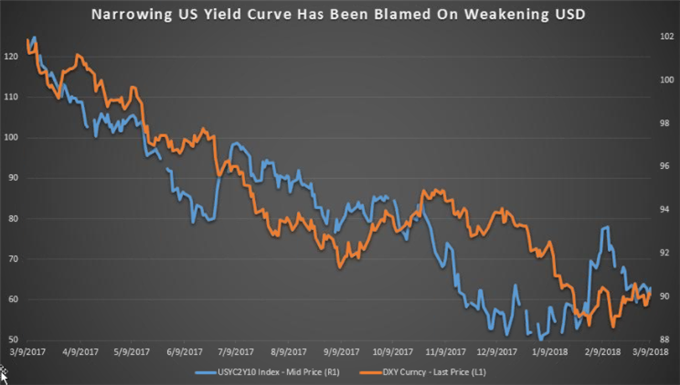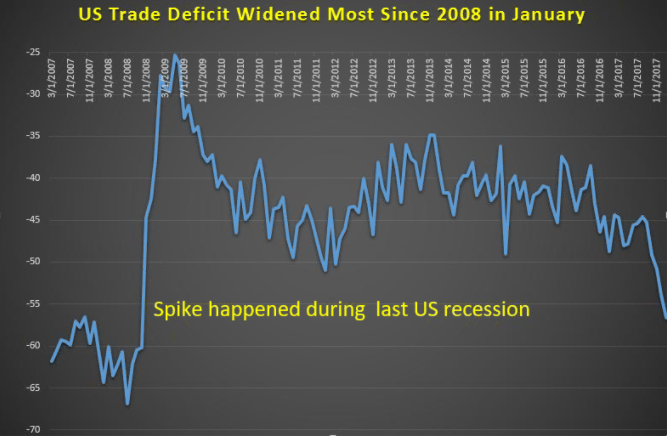Fundamental FX Factors In Focus:
- US yield curves look set for further jumps after aggressive flattening, may limit DXY weakness
- US Current Account deficit widening puts twin deficit in key focus
- Growth puts risk buyers back in the drivers seat
2017 was a year marked by constant surprise that stocks were not falling after the global political landscape was shaken so aggressively in 2016 through multiple elections. So far, while 2018 has had volatility spikes early on that fundamentally shook the comfort out of many investors, there also appears to be a fulfillment of the new post-crisis and central bank intervention market.
Naturally, traders and investors have never come out of a market so heavily supported by low sovereign yields that made borrowing cheap thanks in large part to central banks buying debt at historic levels. However, inflation has become the key factor that some say is missing and otherssay cannot rise without aggressively breaking the confidence that has marked recent leg of the extended risk rally.
Unfamiliar with Key FX Fundamental Factors to watch? No worries, I created a primer for you here
Fixed Income or sovereign bonds give traders a wealth of information that makes them impossible to ignore if you’re trying to grasp capital flows and drivers of growth. As explained in the primer piece, because fixed-income securities give investors fixed coupons (give or take a return to par if purchased at a discount or premium if purchased after issuance in the secondary market), they are uniquely concerned about inflation. When receiving a fixed series of payments for a period of time, a rising rate of inflation is the second worst enemy aside from default to investors.
Since 2016, global bond yields have been moving higher meaning that the securities themselves are moving further away from par. Given the historic low in yields (premium in debt issuance) seen over the last few years, the rise in yields and specifically, the flattening of yield spreads over different tenors are causing investors to question where the next big opportunity lies.
Yield Curve (Blue Line) Falling Alongside Dollar Index (Orange Line)

Data Source: Bloomberg. Chart created by Tyler Yell, CMT
Non-Farm Payroll in the US Shows Inflation Concerns May Have Been Overdone
Goldilocks is a term used to describe a news release that shows an economy is running hot, but not too hot for concern that would cause a central bank to sound an alarm. The traditional headline number for Friday NFP showed the US added 313k jobs and outshone while the focus was on the Average Hourly Earnings or Wage Inflation component. Such a number bodes well for GDP growth with stable participation while wage inflation decelerated after January’s aggressive rise.
Next week, US CPI will also shine a spotlight on inflation pressures, and whether they’re increasing or diminishing.
The yield curve flattening above is known as bear flattening, which historically has been a development where riskier assets have outperformed. Bear flattening often happens when the short-end or in the yield curve used above known as, the US 2 year rate increases more than the long-term or US 10 year rate. Typically, this is because long-term growth is in doubt when compared to short-term growth or inflation drivers.
Friday’s CFTC Commitment of Traders report showed the bear flattening trend has the full support of institutions that sold bonds on the back end of the yield curve with more aggressive shorts showing up in the belly of the curve.
Trade Wars Turn Focus on Widening US Deficit As US’ Borrowing Needs Rise

Data Source: Bloomberg
The drop on the chart above shows a move away from a balanced budget of the US Current Account. A current account deficit means an economy is funded externally. The key point is that the funding needs of the US are only accelerating. Add to that, there remains confusion on who will bear the brunt of the tariff’s signed into law by President Trump this week, and specifically if the large buyers of US Treasuries (those who keep yields from skyrocketing) will keep buying issuances especially if they feel they are on the wrong end of the Tariff’s.
Either way, the week ended on a positive note, as evidenced by the Nasdaq trading to fresh records. At the beginning of the week, there was what could have been the start of a trade war, concerns of US inflation and uncertainty around how the ECB might shake the boat. 5-days later, implied volatility continues to fall showing investors no longer remained concerned after learning of potential carve-outs to the largest exporters of steel like Canada and Mexico.
Growth Dynamics Continue To Remain Supportive
Debt and supply are only an issue when growth cools to the point that they cannot be serviced. A proxy for global growth is Emerging Markets, and while they have been cooling off lately a string of positive developments have come to the scene.
Citi Economic Surprise Index – Emerging Markets

Date source: Citigroup, Bloomberg
The surprise factor of Emerging Market economic data points are the strongest relative to expectations in nearly a year. It’s too early to make a trend of this, but traders should understand that a legitimate shock rise in growth of Emerging Markets, whether through commodity demand or organic growth could keep the buying of risk in vogue for the foreseeable future.
FX traders may decide to go straight to Emerging Markets, similar to what was argued in this article on the Mexican Peso or to high-beta G10 FX, which Ichimoku may be showing the worst is over if support holds. The most recent Ichimoku Report can be found here.
New to FX trading? No worries, we created this guide just for you.
---Written by Tyler Yell, CMT
Tyler Yell is a Chartered Market Technician. Tyler provides Technical analysis that is powered by fundamental factors on key markets as well as t1rading educational resources. Read more of Tyler’s Technical reports via his bio page.
Communicate with Tyler and have your shout below by posting in the comments area. Feel free to include your market views as well.
Discuss this market with Tyler in the live webinar, FX Closing Bell, Weekdays Monday-Thursday at 3 pm ET.
Talk markets on twitter @ForexYell
Join Tyler’s distribution list.






